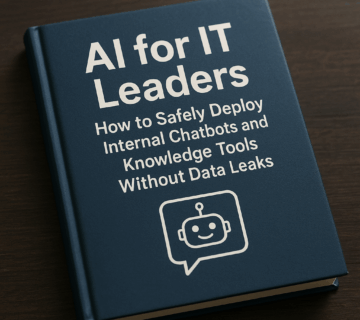New AI Attack Exploits Image Downscaling to Hide Malicious Data-Theft Prompts
🎙️ Dive Deeper with Our Podcast!
Steganographic Attacks Exploit Image Downscaling in AI Systems
👉 Listen to the Episode: https://technijian.com/podcast/steganographic-attacks-exploit-image-downscaling-in-ai-systems/
A groundbreaking security vulnerability has emerged in the artificial intelligence landscape, threatening the safety of user data through an ingenious exploitation of image processing systems. Security researchers have uncovered a sophisticated attack method that weaponizes the routine process of image downscaling to inject hidden malicious instructions directly into AI systems.
The Discovery Behind the Attack
Leading cybersecurity researchers Kikimora Morozova and Suha Sabi Hussain from Trail of Bits have developed this novel attack methodology, building upon foundational research from a 2020 USENIX paper published by TU Braunschweig university in Germany. Their work transforms theoretical concepts about image-scaling vulnerabilities in machine learning into a practical, demonstrable threat.
This innovative attack represents a significant evolution in prompt injection techniques, exploiting a fundamental aspect of how AI systems process visual content. Unlike traditional attack vectors that rely on obvious text-based manipulation, this method operates through steganographic principles embedded within image data itself.
Understanding the Technical Mechanics
1. The Image Processing Vulnerability
Modern AI platforms automatically reduce image quality when users upload visual content, primarily for performance optimization and cost management. This standard practice involves various resampling algorithms, including nearest neighbor interpolation, bilinear interpolation, and bicubic interpolation methods. Each downscaling algorithm introduces specific mathematical artifacts known as aliasing effects. Cybercriminals can engineer images to exploit these predictable weaknesses, embedding data-theft prompts in downscaled images so that concealed patterns surface only during the resizing process.
2. The Steganographic Execution
The attack operates through carefully constructed full-resolution images containing instructions completely invisible to human observers. When AI systems process these images through downscaling algorithms, specific dark regions transform dramatically, revealing hidden text elements that appear as red patterns with black text overlay.
The AI model processes this emergent text as legitimate user instructions, seamlessly integrating malicious commands with authentic user inputs. From the user’s perspective, the interaction appears entirely normal, while the system secretly executes unauthorized operations that could compromise sensitive information.
Real-World Attack Demonstrations
1. Google Gemini Exploitation
Researchers successfully demonstrated the attack against Google’s Gemini CLI system, achieving unauthorized access to Google Calendar data. Through integration with Zapier MCP configured with ‘trust=True’ settings, the attack automatically executed tool calls without requiring user confirmation, enabling data exfiltration to arbitrary email addresses.
2. Confirmed Vulnerable Systems
The research team validated their attack methodology against multiple AI platforms, confirming vulnerabilities across:
- Google Gemini CLI interface
- Vertex AI Studio utilizing Gemini backend systems
- Gemini’s standard web interface
- Gemini API accessed through llm CLI tools
- Google Assistant on Android mobile devices
- Genspark AI platform
The widespread nature of this vulnerability suggests potential impact across numerous additional AI systems that employ similar image processing workflows.
The Anamorpher Tool Release
To demonstrate their findings and facilitate further research, Trail of Bits developed Anamorpher, an open-source tool currently in beta testing. This application enables security researchers to generate malicious images tailored for specific downscaling algorithms, providing a practical framework for testing system vulnerabilities.
The tool’s availability allows organizations to proactively assess their AI systems’ susceptibility to this attack vector, enabling better preparation and defense implementation.
Impact on AI Security Landscape
1. Data Privacy Implications
This form of attack presents significant threats to both personal privacy and the protection of sensitive data. Malicious actors could potentially access personal information, corporate data, or sensitive communications without triggering traditional security alerts or user awareness.
2. Trust in AI Systems
The discovery highlights fundamental security gaps in AI system design, potentially undermining user confidence in AI platforms that handle sensitive information or perform automated tasks on behalf of users.
Defensive Strategies and Mitigation Approaches
Immediate Technical Solutions
Security experts recommend implementing several defensive measures to protect against these attacks:
- Dimension Restrictions: AI systems should enforce strict limitations on uploaded image dimensions, preventing the high-resolution images necessary for successful exploitation.
- Preview Implementation: Platforms should provide users with clear previews showing exactly how images appear to the underlying language model after processing, enabling detection of emergent malicious content.
- Enhanced Confirmation Protocols: Systems should require explicit user confirmation for sensitive operations, particularly when text content is detected within processed images.
Comprehensive Security Architecture
Beyond immediate fixes, researchers advocate for fundamental improvements in AI system design. This includes implementing systematic defenses against prompt injection attacks and adopting secure design patterns specifically developed for large language model protection.
The most effective long-term solution involves building AI systems with inherent resistance to prompt injection techniques, rather than relying solely on detection and mitigation after attacks occur.
Industry Response and Future Implications
1. Vendor Notifications
Trail of Bits researchers have responsibly disclosed their findings to affected vendors, allowing time for security patches and system improvements before public revelation of the attack methodology.
2. Regulatory Considerations
This discovery may prompt regulatory bodies to establish stricter guidelines for AI system security, particularly regarding image processing and user data protection protocols.
Frequently Asked Questions
Q:1 How can regular users protect themselves from this type of attack? A: Users should be cautious when uploading images to AI systems, especially those containing sensitive information. Avoid using AI platforms for highly confidential tasks until vendors implement proper security measures.
Q:2 Can antivirus software detect these malicious images? A: Traditional antivirus solutions may not detect these attacks since the malicious content only becomes visible after specific processing algorithms are applied. Specialized security tools designed for AI systems would be more effective.
Q:3 Are all AI image processing systems vulnerable to this attack? A: While the research focused on specific platforms, any AI system that downscales images before processing could potentially be vulnerable. The attack must be customized for each system’s specific downscaling algorithm.
Q:4 How quickly can vendors fix this vulnerability? A: Implementation timelines vary depending on system architecture. Simple fixes like dimension restrictions could be deployed rapidly, while comprehensive security overhauls may require months of development and testing.
Q:5 Does this affect mobile AI applications? A: Yes, the researchers successfully demonstrated the attack against Google Assistant on Android devices, indicating mobile AI applications are equally susceptible to this vulnerability.
How Technician Can Help Secure Your AI Systems
As cybersecurity threats continue evolving, partnering with experienced security professionals becomes increasingly critical for organizational protection. Technician offers comprehensive AI security assessment services designed to identify and mitigate vulnerabilities like image-based prompt injection attacks.
Our team of certified security experts provides thorough penetration testing specifically tailored for AI systems, including evaluation of image processing workflows, prompt injection resistance, and data exfiltration prevention measures. We work closely with organizations to implement robust security architectures that protect against both current and emerging AI-specific threats.
Through our specialized consulting services, we help businesses develop secure AI implementation strategies, conduct regular security audits, and maintain compliance with evolving cybersecurity standards. Contact Technician today to ensure your AI systems remain secure against sophisticated attack vectors and protect your valuable data assets from unauthorized access.
About Technijian
Technijian is a premier managed IT services provider, committed to delivering innovative technology solutions that empower businesses across Southern California. Headquartered in Irvine, we offer robust IT support and comprehensive managed IT services tailored to meet the unique needs of organizations of all sizes. Our expertise spans key cities like Aliso Viejo, Anaheim, Brea, Buena Park, Costa Mesa, Cypress, Dana Point, Fountain Valley, Fullerton, Garden Grove, and many more. Our focus is on creating secure, scalable, and streamlined IT environments that drive operational success.
As a trusted IT partner, we prioritize aligning technology with business objectives through personalized IT consulting services. Our extensive expertise covers IT infrastructure management, IT outsourcing, and proactive cybersecurity solutions. From managed IT services in Anaheim to dynamic IT support in Laguna Beach, Mission Viejo, and San Clemente, we work tirelessly to ensure our clients can focus on business growth while we manage their technology needs efficiently.
At Technijian, we provide a suite of flexible IT solutions designed to enhance performance, protect sensitive data, and strengthen cybersecurity. Our services include cloud computing, network management, IT systems management, and disaster recovery planning. We extend our dedicated support across Orange, Rancho Santa Margarita, Santa Ana, and Westminster, ensuring businesses stay adaptable and future-ready in a rapidly evolving digital landscape.
Our proactive approach to IT management also includes help desk support, cybersecurity services, and customized IT consulting for a wide range of industries. We proudly serve businesses in Laguna Hills, Newport Beach, Tustin, Huntington Beach, and Yorba Linda. Our expertise in IT infrastructure services, cloud solutions, and system management makes us the go-to technology partner for businesses seeking reliability and growth.
Partnering with Technijian means gaining a strategic ally dedicated to optimizing your IT infrastructure. Experience the Technijian Advantage with our innovative IT support services, expert IT consulting, and reliable managed IT services in Irvine. We proudly serve clients across Irvine, Orange County, and the wider Southern California region, helping businesses stay secure, efficient, and competitive in today’s digital-first world.





